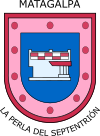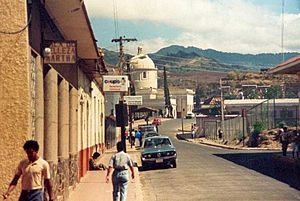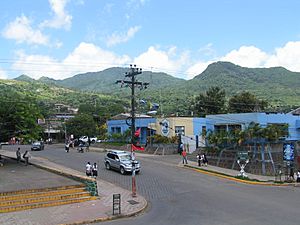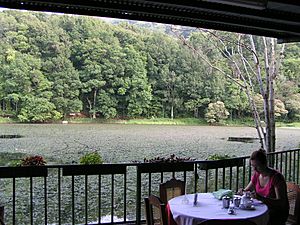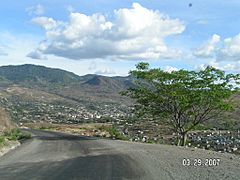Matagalpa facts for kids
Quick facts for kids
Matagalpa
San Pedro de Matagalpa
|
|||
|---|---|---|---|
|
Municipality
|
|||
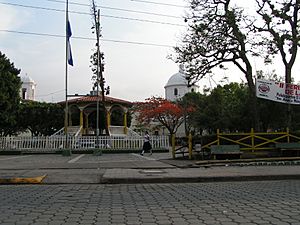
Matagalpa's Cathedral
|
|||
|
|||
| Country | |||
| Department | Matagalpa Department | ||
| Area | |||
| • Municipality | 619 km2 (239 sq mi) | ||
| Population
(2022 estimate)
|
|||
| • Municipality | 169,540 | ||
| • Density | 273.89/km2 (709.4/sq mi) | ||
| • Urban | 112,697 (7th Nicaragua) | ||
| Climate | Aw | ||
Matagalpa is a lively city in Nicaragua. It is the capital of the Matagalpa department. About 112,697 people live in the city (2022 estimate). The whole department has a population of 606,643. Matagalpa is Nicaragua's seventh largest city. It is the biggest city in the country's central area. It is also one of the busiest cities for business outside of Managua, the capital. People often call Matagalpa the "Pearl of the North." It is also known as the "Land of Eternal Spring."
Contents
What Matagalpa Means
Historians have different ideas about the name "Matagalpa." Jeronimo Perez, a historian from the 1850s, thought it meant "Main Head" or "Big Town." These words come from the old Matagalpa language.
However, a linguist named Father Guillermo Kiene had another idea. He was a Catholic priest who lived in Matagalpa. He believed the name came from the Sumo language. To him, "Matagalpa" meant "let's go where the rocks are."
Other ideas for the name include "Here next to the water" and "Among Mountains." These names likely describe the city's location. Matagalpa is next to the Grand River of Matagalpa. It is also surrounded by many mountains.
Matagalpa's History
Early History of Matagalpa
Matagalpa started as a village for indigenous people. The Cacaopera people, also called Matagalpa, had their own language. Sadly, this language died out around 1875. You can find a document from 1855 with 97 words from their language. It is kept in a library in Philadelphia.
The Matagalpa people were skilled artists. They made special pottery called "Ceramica Negra" and "Naranja Segovia." They also carved stone statues of their leaders and warriors. The Spanish respected them because they were very brave. They were also good with bows and other weapons. It took the Spanish 300 years to control them. Even when Nicaragua became independent in 1821, many Cacaopera people were still free. They lived in the central mountains of Nicaragua.
In 1856, the Cacaopera people played a big part in a famous battle. They helped defeat William Walker's army. Walker was an American adventurer who tried to take over Nicaragua. In the Battle of San Jacinto on September 14, 1856, 60 Cacaopera warriors fought. They used bows and arrows alongside Nicaraguan soldiers. Their help led to a victory that ended Walker's control. Many people want the Cacaopera to be named National Heroes for their bravery.
Matagalpa After Colonial Times
Matagalpa was already a town when the first Spaniards arrived in 1528. They were looking for a water route to the Caribbean Sea. Nicaragua was first colonized by Spain from the Pacific Ocean side.
Matagalpa is located on a special line called the continental divide. This line separates rivers that flow to the Pacific Ocean from those that flow to the Caribbean Sea. There are many old stories from colonial times. They tell about the British-controlled Caribbean coast and the Spanish-controlled Pacific area.
Gold was found near Matagalpa around 1840. This discovery brought many people to the area. Spaniards and Mestizos came, along with immigrants from Germany, America, and Britain. Two famous immigrants were Ludwig Elster and Katharina Braun from Germany. They planted the first coffee trees in the area. The coffee beans quickly became popular in Germany. Growing coffee brought over 120 European immigrants to Matagalpa. Many of them married local women. Their families still live in the area today.
In 1923, some Danish immigrants also came to Matagalpa. They settled in the high mountain areas. Most of these Danish families eventually returned to Denmark. However, three families stayed: the Gröns, the Möllers, and the Petersens.
Matagalpa also became a safe place for many Nicaraguans. They were escaping the invasion of William Walker. He was an American adventurer who took control of much of the country in 1856. In Matagalpa, patriots formed the "Army of the North." This army fought and won the Battle of San Jacinto on September 14, 1856. Sixty Matagalpa warriors helped them win. This victory helped end Walker's rule in Nicaragua.
The Matagalpa Department is also famous for being the birthplace of important people. These include Rubén Darío, a famous poet (1867-1916). Also, Nazario Vega, who was a governor and helped build the Cathedral. Bartolomé Martínez was President of Nicaragua from 1923–24. Carlos Fonseca Amador founded the Sandinista Front in 1961.
Today, the Matagalpa department is the second most populated in Nicaragua. Only the capital, Managua, has more people. Matagalpa has a very diverse economy. In recent years, many people have moved to Matagalpa. This has put some pressure on the city's services and environment.
Matagalpa has a beautiful highway. It starts in the city and goes for 30 kilometers (19 miles) to Jinotega. From this road, you can see amazing views. On clear days, you can see up to 140 kilometers (87 miles) away. You can even see the volcanoes near the Pacific coast.
Many experts visit Matagalpa to study its history, plants, and people. Descendants of the first European settlers also come back. They want to visit the homes of their ancestors.
Matagalpa's Economy
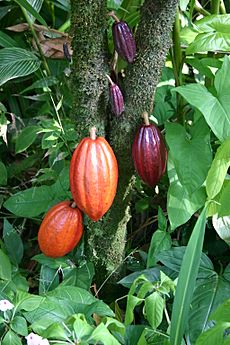
Matagalpa is important for Nicaragua's economy. It produces and sells many things. These include beef, cheese, coffee, and cacao. Farmers also grow onions, tomatoes, and various fruits and vegetables. For local use, they grow flowers, wood, corn, and beans. They also grow fruits like oranges, grapefruits, bananas, and plantains. Many kinds of vegetables, like broccoli and cauliflower, are also grown here.
Matagalpa is especially famous for its coffee. It is also known for its cattle and milk products. The region's beautiful mountains are popular for ecotourism. There are famous mountain resorts like Aranjuez, Santa Maria de Ostuma, and Selva Negra Mountain Resort.
A big part of Matagalpa's economy comes from eco-tourism. People enjoy nature hikes and excursions throughout the region. One well-known eco-tourism spot is the Selva Negra Wildlife Refuge. It has over 120 hectares (300 acres) of land. This land is set aside to protect the area's many plants and animals.
Matagalpa's Climate
Matagalpa and nearby Jinotega are known for their "eternal spring" weather. This means they have spring-like temperatures all year. Matagalpa is located more than 700 meters (2,300 feet) above sea level. The average temperature is between 26 and 28 °C (79 and 82 °F). The air is usually quite humid, between 75% and 85%. The city gets about 1,200 to 1,900 mm (47 to 75 inches) of rain each year.
Gallery
Notable People from Matagalpa
- Carlos Fonseca, founder of the FSLN political party
- Dorothy Granada, an American nurse and humanitarian. She started a women's health clinic and won a peace award.
- Marina Jacoby, Miss Nicaragua 2016
- Bartolome Martinez, President of Nicaragua from 1923-1924
- Byron Rojas, a professional boxer
Matagalpa's Sister Cities
Matagalpa has special connections with many cities around the world. These are called "twin towns" or "sister cities." They work together to share culture and ideas.
 Wuppertal, Germany
Wuppertal, Germany Tilburg, Netherlands
Tilburg, Netherlands Sabadell, Spain
Sabadell, Spain Gainesville, United States
Gainesville, United States San Pedro Sula, Honduras
San Pedro Sula, Honduras Lewisham, United Kingdom
Lewisham, United Kingdom Valparaíso, Chile
Valparaíso, Chile San Francisco, United States
San Francisco, United States Retalhuleu, Guatemala
Retalhuleu, Guatemala Heredia, Costa Rica
Heredia, Costa Rica Oulu, Finland
Oulu, Finland Colón, Panama
Colón, Panama Antigua Guatemala, Guatemala
Antigua Guatemala, Guatemala Cojutepeque, El Salvador
Cojutepeque, El Salvador Saint Petersburg, Russia
Saint Petersburg, Russia Shanghai, China
Shanghai, China Jalisco, Mexico
Jalisco, Mexico
See also
 In Spanish: Matagalpa para niños
In Spanish: Matagalpa para niños



